stop start TOYOTA COROLLA HATCHBACK 2022 (in English) Service Manual
[x] Cancel search | Manufacturer: TOYOTA, Model Year: 2022, Model line: COROLLA HATCHBACK, Model: TOYOTA COROLLA HATCHBACK 2022Pages: 758, PDF Size: 155.26 MB
Page 282 of 758
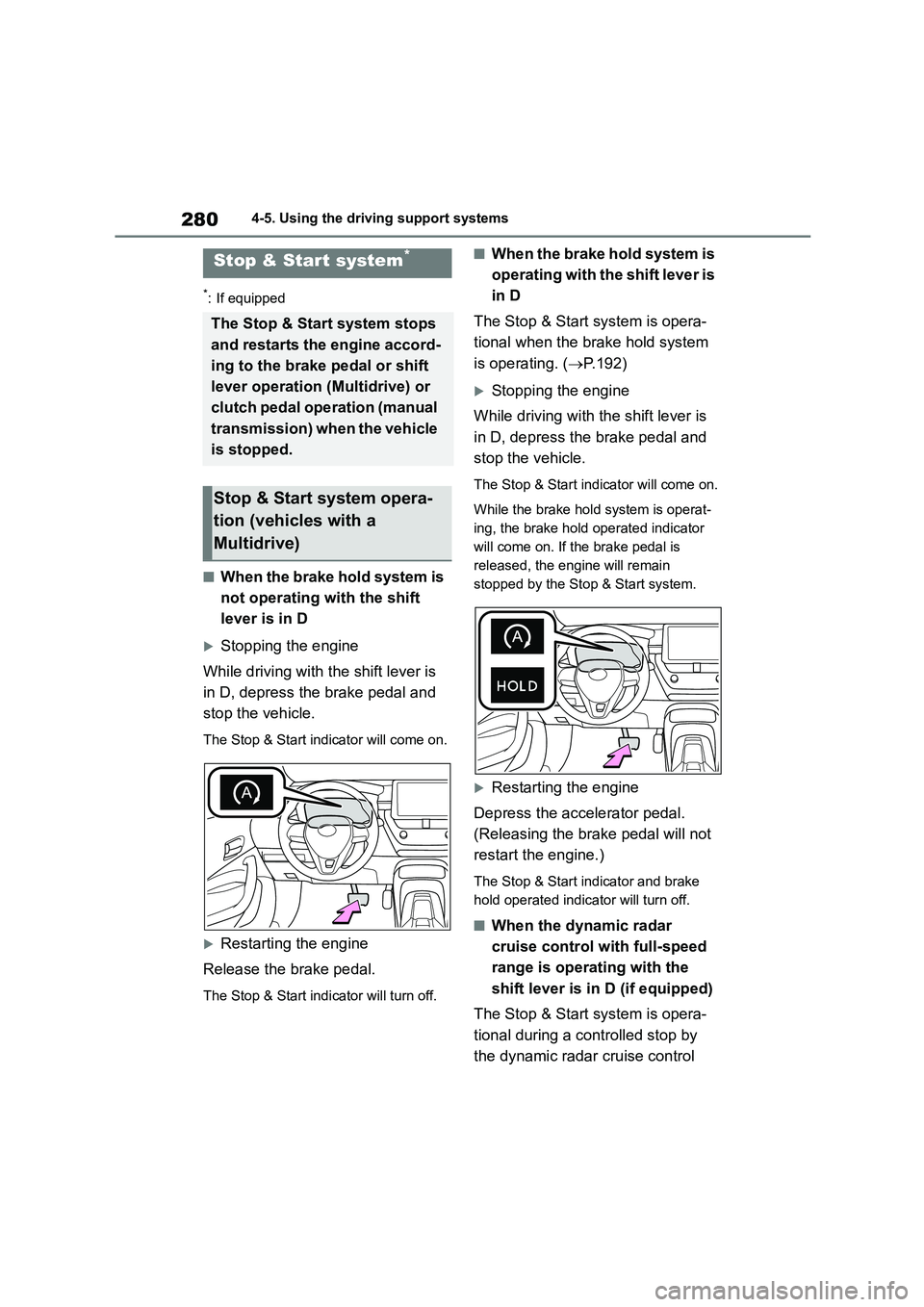
2804-5. Using the driving support systems
*: If equipped
■When the brake hold system is
not operating with the shift
lever is in D
Stopping the engine
While driving with the shift lever is
in D, depress the brake pedal and
stop the vehicle.
The Stop & Start indicator will come on.
Restarting the engine
Release the brake pedal.
The Stop & Start indicator will turn off.
■When the brake hold system is
operating with the shift lever is
in D
The Stop & Start system is opera-
tional when the brake hold system
is operating. ( P.192)
Stopping the engine
While driving with the shift lever is
in D, depress the brake pedal and
stop the vehicle.
The Stop & Start indicator will come on.
While the brake hold system is operat-
ing, the brake hold operated indicator
will come on. If the brake pedal is
released, the engine will remain
stopped by the Stop & Start system.
Restarting the engine
Depress the accelerator pedal.
(Releasing the brake pedal will not
restart the engine.)
The Stop & Start indicator and brake
hold operated indicator will turn off.
■When the dynamic radar
cruise control with full-speed
range is operating with the
shift lever is in D (if equipped)
The Stop & Start system is opera-
tional during a controlled stop by
the dynamic radar cruise control
Stop & Start system*
The Stop & Start system stops
and restarts the engine accord-
ing to the brake pedal or shift
lever operation (Multidrive) or
clutch pedal operation (manual
transmission) when the vehicle
is stopped.
Stop & Start system opera-
tion (vehicles with a
Multidrive)
Page 283 of 758
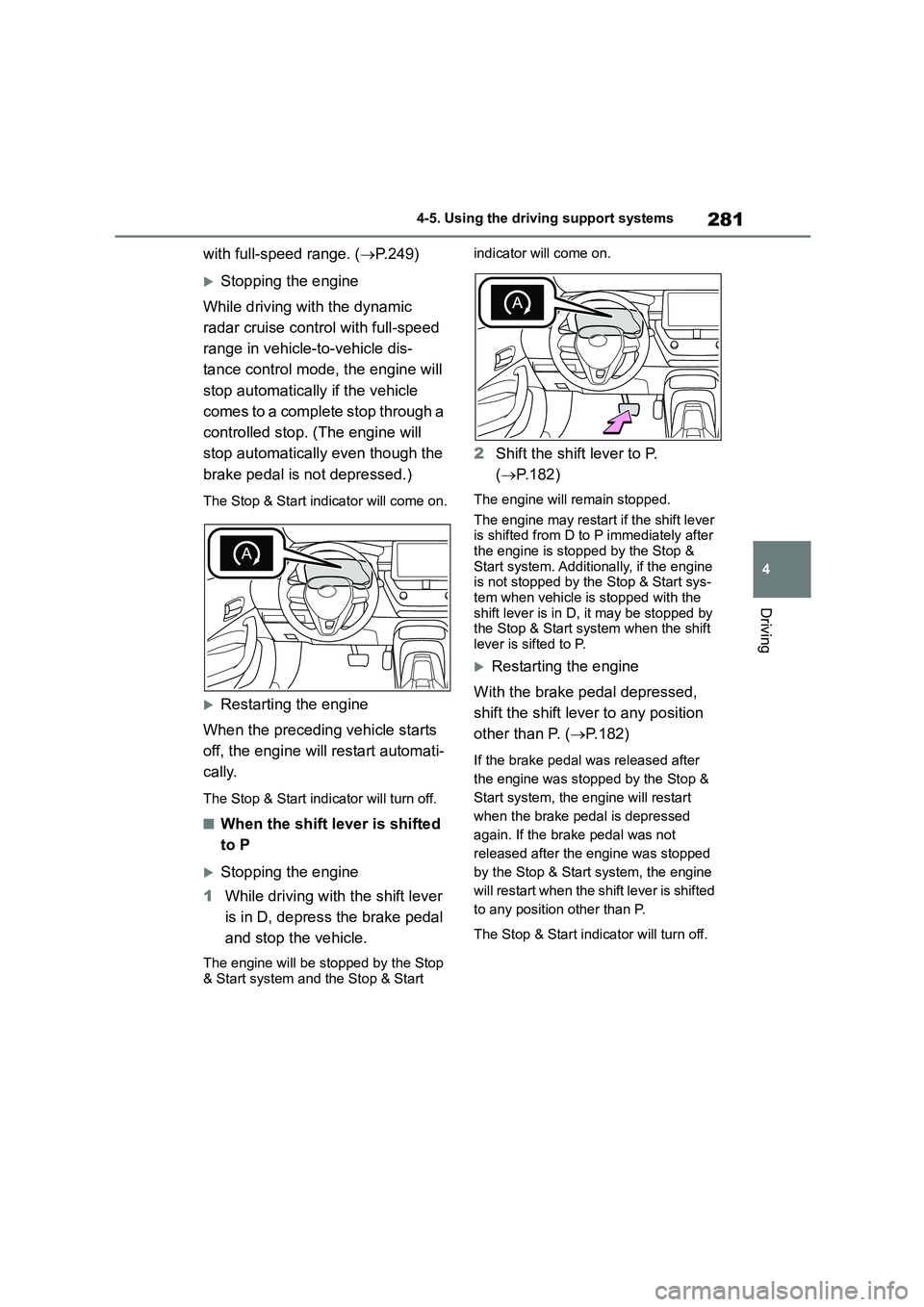
281
4
4-5. Using the driving support systems
Driving
with full-speed range. ( P.249)
Stopping the engine
While driving with the dynamic
radar cruise control with full-speed
range in vehicle-to-vehicle dis-
tance control mode, the engine will
stop automatically if the vehicle
comes to a complete stop through a
controlled stop. (T he engine will
stop automatically even though the
brake pedal is not depressed.)
The Stop & Start indicator will come on.
Restarting the engine
When the preceding vehicle starts
off, the engine w ill restart automati-
cally.
The Stop & Start indicator will turn off.
■When the shift lever is shifted
to P
Stopping the engine
1 While driving with the shift lever
is in D, depress the brake pedal
and stop the vehicle.
The engine will be stopped by the Stop
& Start system and the Stop & Start
indicator will come on.
2 Shift the shift lever to P.
( P.182)
The engine will remain stopped.
The engine may restart if the shift lever
is shifted from D to P immediately after the engine is stopped by the Stop &
Start system. Additional ly, if the engine
is not stopped by the Stop & Start sys- tem when vehicle is stopped with the
shift lever is in D, it may be stopped by
the Stop & Start system when the shift lever is sifted to P.
Restarting the engine
With the brake pedal depressed,
shift the shift lever to any position
other than P. ( P.182)
If the brake pedal was released after
the engine was stopped by the Stop &
Start system, the engine will restart
when the brake pedal is depressed
again. If the brake pedal was not
released after the engine was stopped
by the Stop & Star t system, the engine
will restart when the shift lever is shifted
to any position other than P.
The Stop & Start indicator will turn off.
Page 284 of 758
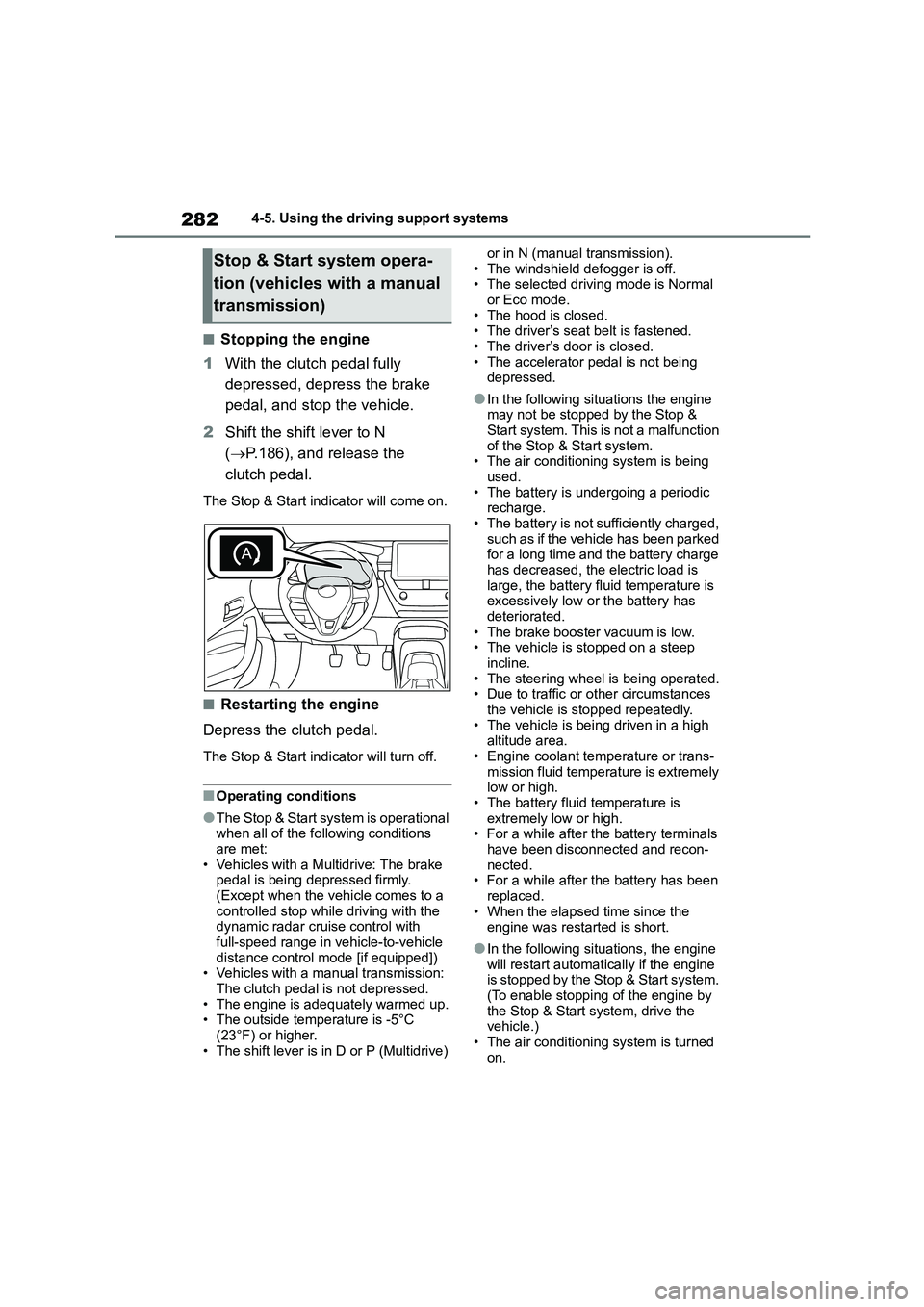
2824-5. Using the driving support systems
■Stopping the engine
1 With the clutch pedal fully
depressed, depress the brake
pedal, and stop the vehicle.
2 Shift the shift lever to N
( P.186), and release the
clutch pedal.
The Stop & Start indicator will come on.
■Restarting the engine
Depress the clutch pedal.
The Stop & Start indicator will turn off.
■Operating conditions
●The Stop & Start system is operational
when all of the following conditions are met:
• Vehicles with a Multidrive: The brake
pedal is being depressed firmly. (Except when the vehicle comes to a
controlled stop while driving with the
dynamic radar cruise control with
full-speed range in vehicle-to-vehicle distance control mode [if equipped])
• Vehicles with a manual transmission:
The clutch pedal is not depressed. • The engine is adequately warmed up.
• The outside temperature is -5°C
(23°F) or higher. • The shift lever is in D or P (Multidrive)
or in N (manual transmission).
• The windshield defogger is off. • The selected driving mode is Normal
or Eco mode.
• The hood is closed. • The driver’s seat belt is fastened.
• The driver’s door is closed.
• The accelerator pedal is not being depressed.
●In the following situations the engine may not be stopped by the Stop &
Start system. This is not a malfunction
of the Stop & Start system. • The air conditioning system is being
used.
• The battery is undergoing a periodic recharge.
• The battery is not sufficiently charged,
such as if the vehicle has been parked for a long time and the battery charge
has decreased, the electric load is
large, the battery fluid temperature is excessively low or the battery has
deteriorated.
• The brake booster vacuum is low. • The vehicle is stopped on a steep
incline.
• The steering wheel is being operated. • Due to traffic or other circumstances
the vehicle is stopped repeatedly.
• The vehicle is being driven in a high altitude area.
• Engine coolant temperature or trans-
mission fluid temperature is extremely low or high.
• The battery fluid temperature is
extremely low or high. • For a while after the battery terminals
have been disconnected and recon-
nected. • For a while after the battery has been
replaced.
• When the elapsed time since the
engine was restarted is short.
●In the following situations, the engine
will restart automatically if the engine is stopped by the Stop & Start system.
(To enable stopping of the engine by
the Stop & Start system, drive the vehicle.)
• The air conditioning system is turned
on.
Stop & Start system opera-
tion (vehicles with a manual
transmission)
Page 285 of 758
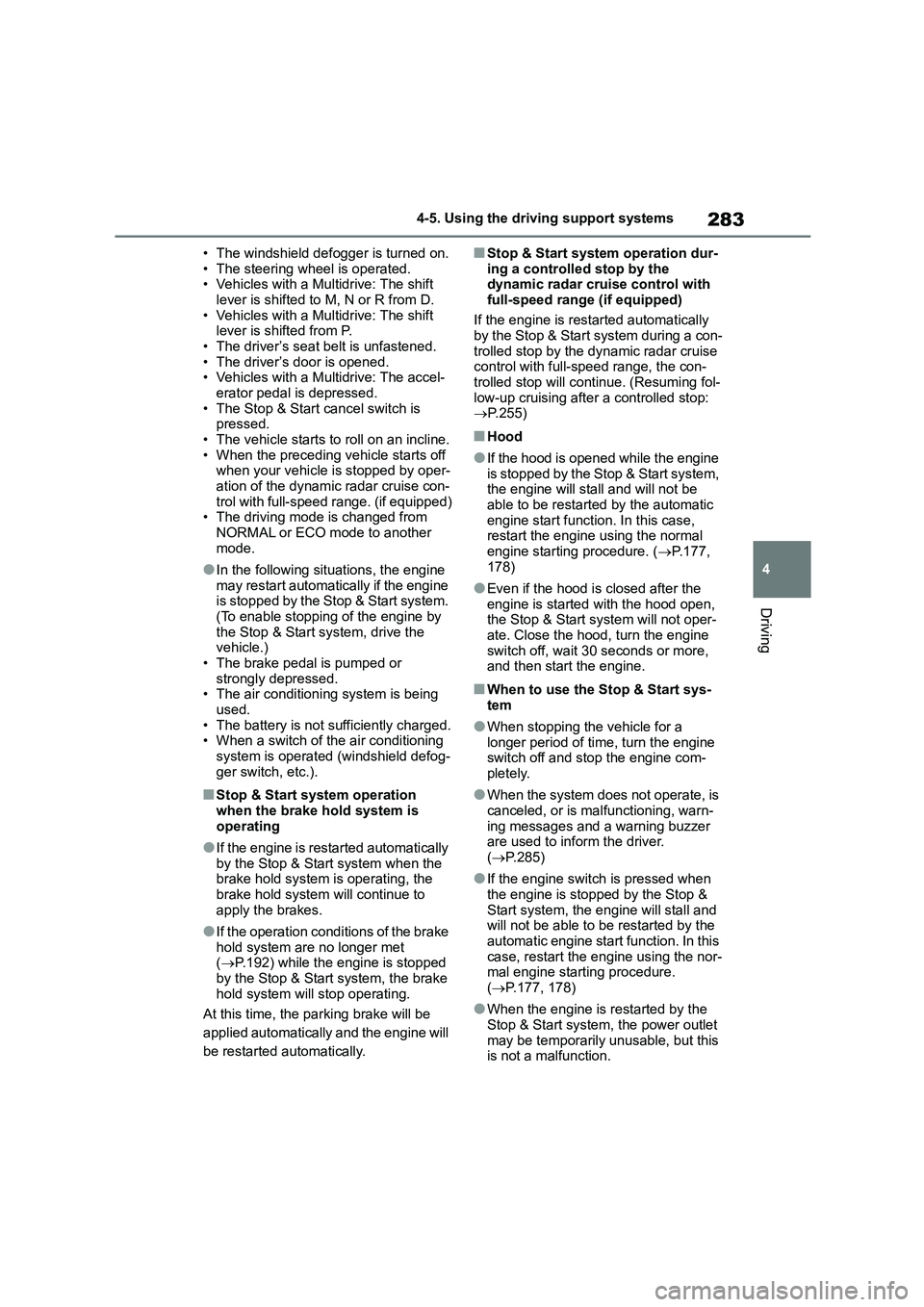
283
4
4-5. Using the driving support systems
Driving
• The windshield defogger is turned on.
• The steering wheel is operated. • Vehicles with a Multidrive: The shift
lever is shifted to M, N or R from D.
• Vehicles with a Multidrive: The shift lever is shifted from P.
• The driver’s seat belt is unfastened.
• The driver’s door is opened. • Vehicles with a Multidrive: The accel-
erator pedal is depressed.
• The Stop & Start cancel switch is pressed.
• The vehicle starts to roll on an incline.
• When the preceding vehicle starts off when your vehicle is stopped by oper-
ation of the dynamic radar cruise con-
trol with full-speed range. (if equipped) • The driving mode is changed from
NORMAL or ECO mode to another
mode.
●In the following situations, the engine
may restart automatically if the engine is stopped by the Stop & Start system.
(To enable stopping of the engine by
the Stop & Start system, drive the vehicle.)
• The brake pedal is pumped or
strongly depressed. • The air conditioni ng system is being
used.
• The battery is not sufficiently charged. • When a switch of the air conditioning
system is operated (windshield defog-
ger switch, etc.).
■Stop & Start system operation when the brake hold system is
operating
●If the engine is restarted automatically
by the Stop & Start system when the
brake hold system is operating, the brake hold system will continue to
apply the brakes.
●If the operation conditions of the brake hold system are no longer met
( P.192) while the engine is stopped
by the Stop & Start system, the brake hold system will stop operating.
At this time, the parking brake will be
applied automatically and the engine will
be restarted automatically.
■Stop & Start system operation dur-
ing a controlled stop by the dynamic radar cruise control with
full-speed range (if equipped)
If the engine is restarted automatically by the Stop & Start system during a con-
trolled stop by the dynamic radar cruise
control with full-sp eed range, the con- trolled stop will continue. (Resuming fol-
low-up cruising after a controlled stop:
P.255)
■Hood
●If the hood is opened while the engine
is stopped by the Stop & Start system, the engine will stall and will not be
able to be restarted by the automatic
engine start function. In this case, restart the engine using the normal
engine starting procedure. ( P.177,
178)
●Even if the hood is closed after the
engine is started with the hood open, the Stop & Start system will not oper-
ate. Close the hood, turn the engine
switch off, wait 30 seconds or more, and then start the engine.
■When to use the Stop & Start sys-
tem
●When stopping the vehicle for a
longer period of time, turn the engine
switch off and stop the engine com- pletely.
●When the system does not operate, is canceled, or is malfunctioning, warn-
ing messages and a warning buzzer
are used to inform the driver. ( P.285)
●If the engine switch is pressed when the engine is stopped by the Stop &
Start system, the engine will stall and
will not be able to be restarted by the
automatic engine start function. In this case, restart the engine using the nor-
mal engine starting procedure.
( P.177, 178)
●When the engine is restarted by the
Stop & Start system, the power outlet may be temporarily unusable, but this
is not a malfunction.
Page 286 of 758
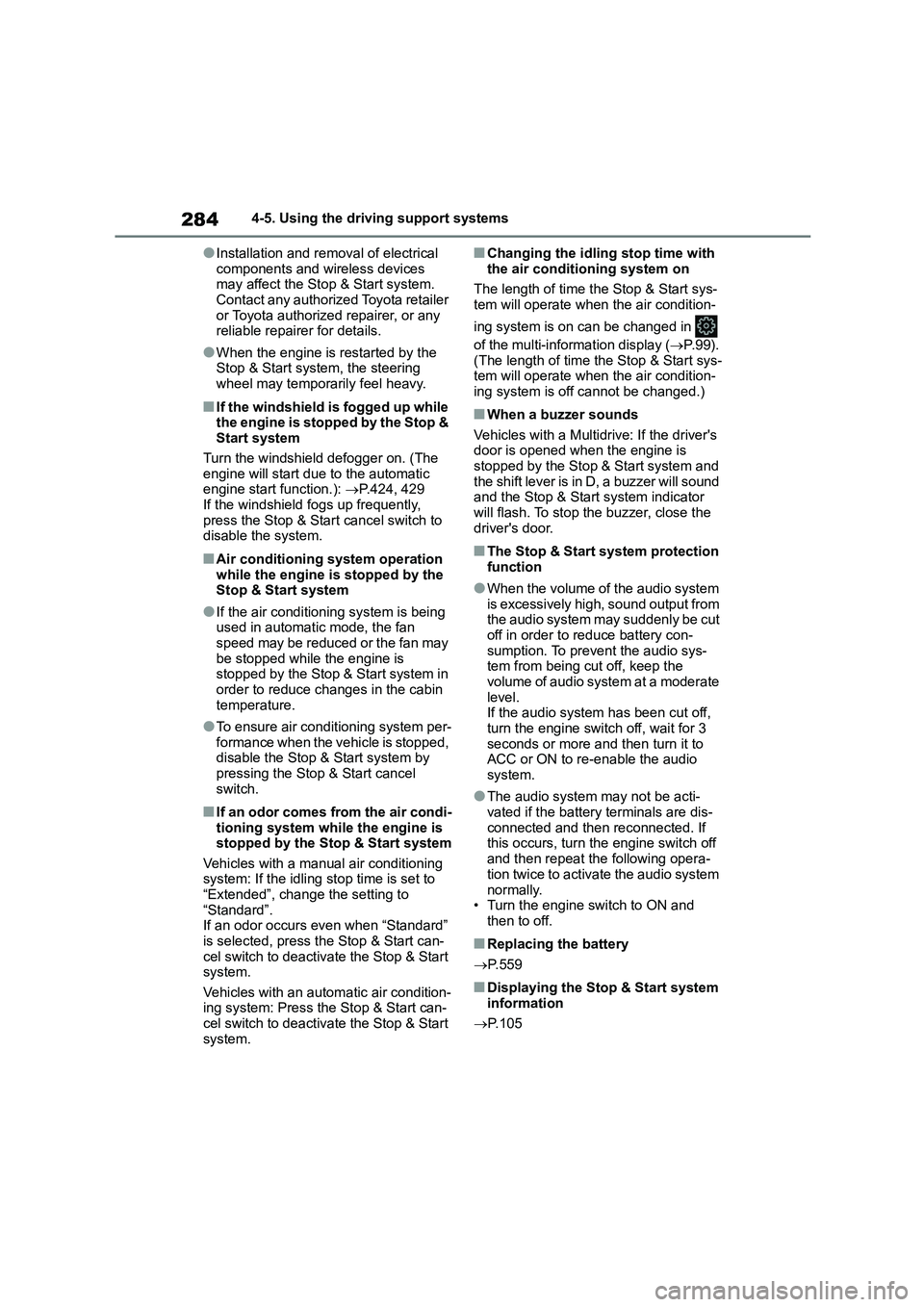
2844-5. Using the driving support systems
●Installation and removal of electrical
components and wireless devices may affect the Stop & Start system.
Contact any authorized Toyota retailer
or Toyota authorized repairer, or any reliable repairer for details.
●When the engine is restarted by the Stop & Start system, the steering
wheel may temporarily feel heavy.
■If the windshield is fogged up while
the engine is stopped by the Stop & Start system
Turn the windshield defogger on. (The
engine will start due to the automatic engine start function.): P.424, 429
If the windshield fogs up frequently,
press the Stop & Start cancel switch to disable the system.
■Air conditioning system operation
while the engine is stopped by the
Stop & Start system
●If the air conditioning system is being
used in automatic mode, the fan speed may be reduced or the fan may
be stopped while the engine is
stopped by the Stop & Start system in order to reduce changes in the cabin
temperature.
●To ensure air cond itioning system per-
formance when the vehicle is stopped,
disable the Stop & Start system by pressing the Stop & Start cancel
switch.
■If an odor comes from the air condi-
tioning system while the engine is stopped by the Stop & Start system
Vehicles with a manual air conditioning
system: If the idling stop time is set to “Extended”, change the setting to
“Standard”.
If an odor occurs even when “Standard”
is selected, press the Stop & Start can- cel switch to deactivate the Stop & Start
system.
Vehicles with an automatic air condition- ing system: Press the Stop & Start can-
cel switch to deactivate the Stop & Start
system.
■Changing the idling stop time with
the air conditioning system on
The length of time the Stop & Start sys-
tem will operate when the air condition-
ing system is on can be changed in
of the multi-information display ( P. 9 9 ) .
(The length of time the Stop & Start sys-
tem will operate when the air condition- ing system is off cannot be changed.)
■When a buzzer sounds
Vehicles with a Multidrive: If the driver's
door is opened when the engine is stopped by the Stop & Start system and
the shift lever is in D, a buzzer will sound
and the Stop & Start system indicator will flash. To stop the buzzer, close the
driver's door.
■The Stop & Start system protection
function
●When the volume of the audio system
is excessively high, sound output from the audio system may suddenly be cut
off in order to reduce battery con-
sumption. To prevent the audio sys- tem from being cut off, keep the
volume of audio system at a moderate
level. If the audio system has been cut off,
turn the engine switch off, wait for 3
seconds or more and then turn it to ACC or ON to re-enable the audio
system.
●The audio system may not be acti-
vated if the battery terminals are dis-
connected and then reconnected. If this occurs, turn the engine switch off
and then repeat the following opera-
tion twice to activate the audio system
normally. • Turn the engine switch to ON and
then to off.
■Replacing the battery
P. 5 5 9
■Displaying the Stop & Start system information
P. 1 0 5
Page 287 of 758
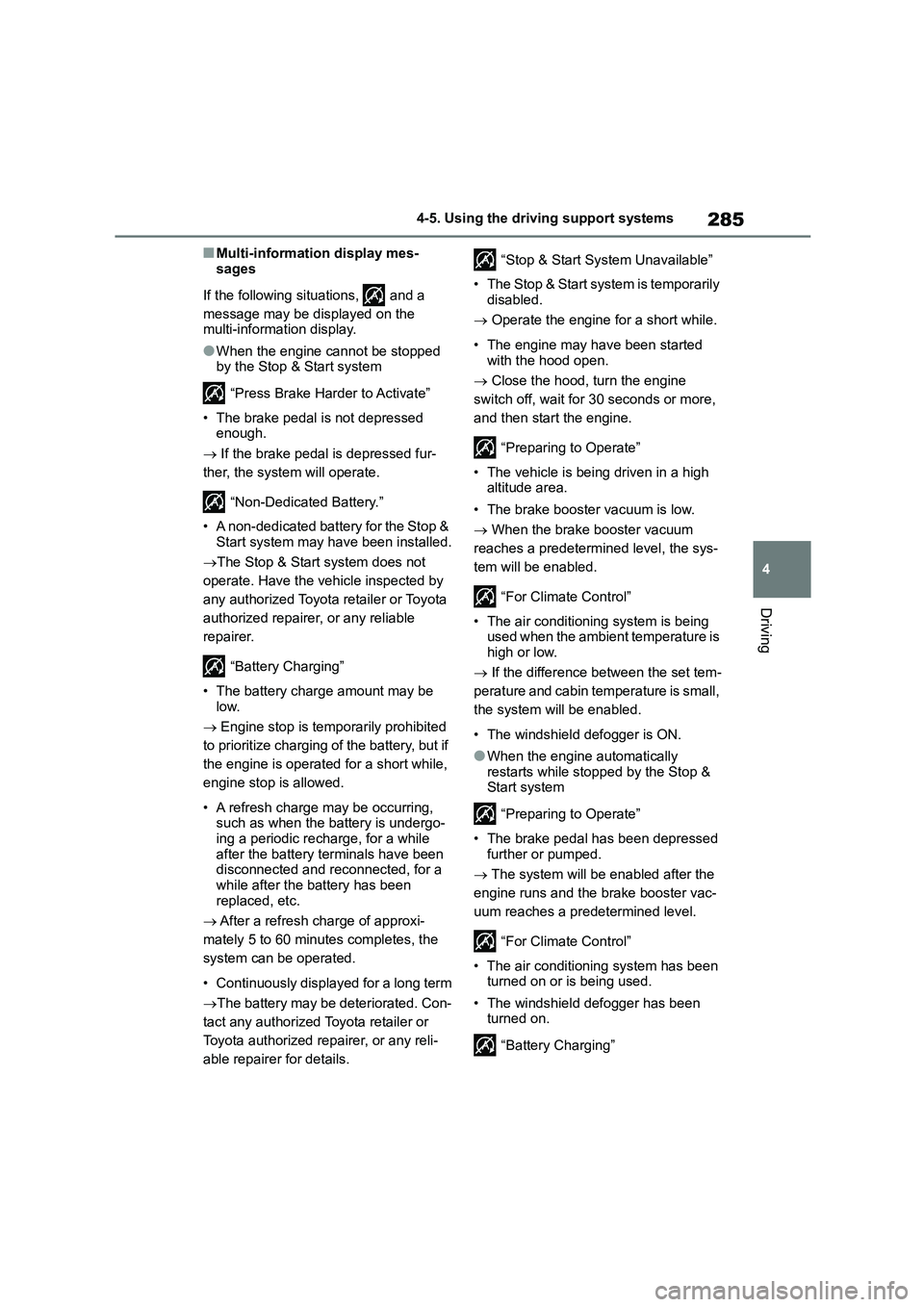
285
4
4-5. Using the driving support systems
Driving
■Multi-information display mes-
sages
If the following situations, and a
message may be displayed on the
multi-information display.
●When the engine cannot be stopped
by the Stop & Start system
“Press Brake Harder to Activate”
• The brake pedal is not depressed enough.
If the brake pedal is depressed fur-
ther, the system will operate.
“Non-Dedicated Battery.”
• A non-dedicated battery for the Stop &
Start system may have been installed.
The Stop & Start system does not
operate. Have the vehicle inspected by
any authorized Toyota retailer or Toyota
authorized repairer, or any reliable
repairer.
“Battery Charging”
• The battery charge amount may be
low.
Engine stop is temporarily prohibited
to prioritize charging of the battery, but if
the engine is operated for a short while,
engine stop is allowed.
• A refresh charge may be occurring,
such as when the battery is undergo-
ing a periodic recharge, for a while after the battery terminals have been
disconnected and reconnected, for a
while after the battery has been replaced, etc.
After a refresh charge of approxi-
mately 5 to 60 minutes completes, the
system can be operated.
• Continuously displayed for a long term
The battery may be deteriorated. Con-
tact any authorized Toyota retailer or
Toyota authorized repairer, or any reli-
able repairer for details.
“Stop & Start System Unavailable”
• The Stop & Start system is temporarily
disabled.
Operate the engine for a short while.
• The engine may have been started
with the hood open.
Close the hood, turn the engine
switch off, wait for 30 seconds or more,
and then start the engine.
“Preparing to Operate”
• The vehicle is being driven in a high
altitude area.
• The brake booster vacuum is low.
When the brake booster vacuum
reaches a predetermined level, the sys-
tem will be enabled.
“For Climate Control”
• The air conditioning system is being
used when the ambient temperature is high or low.
If the difference between the set tem-
perature and cabin temperature is small,
the system will be enabled.
• The windshield defogger is ON.
●When the engine automatically
restarts while stopped by the Stop & Start system
“Preparing to Operate”
• The brake pedal has been depressed further or pumped.
The system will be enabled after the
engine runs and the brake booster vac-
uum reaches a predetermined level.
“For Climate Control”
• The air conditioning system has been
turned on or is being used.
• The windshield defogger has been
turned on.
“Battery Charging”
Page 288 of 758
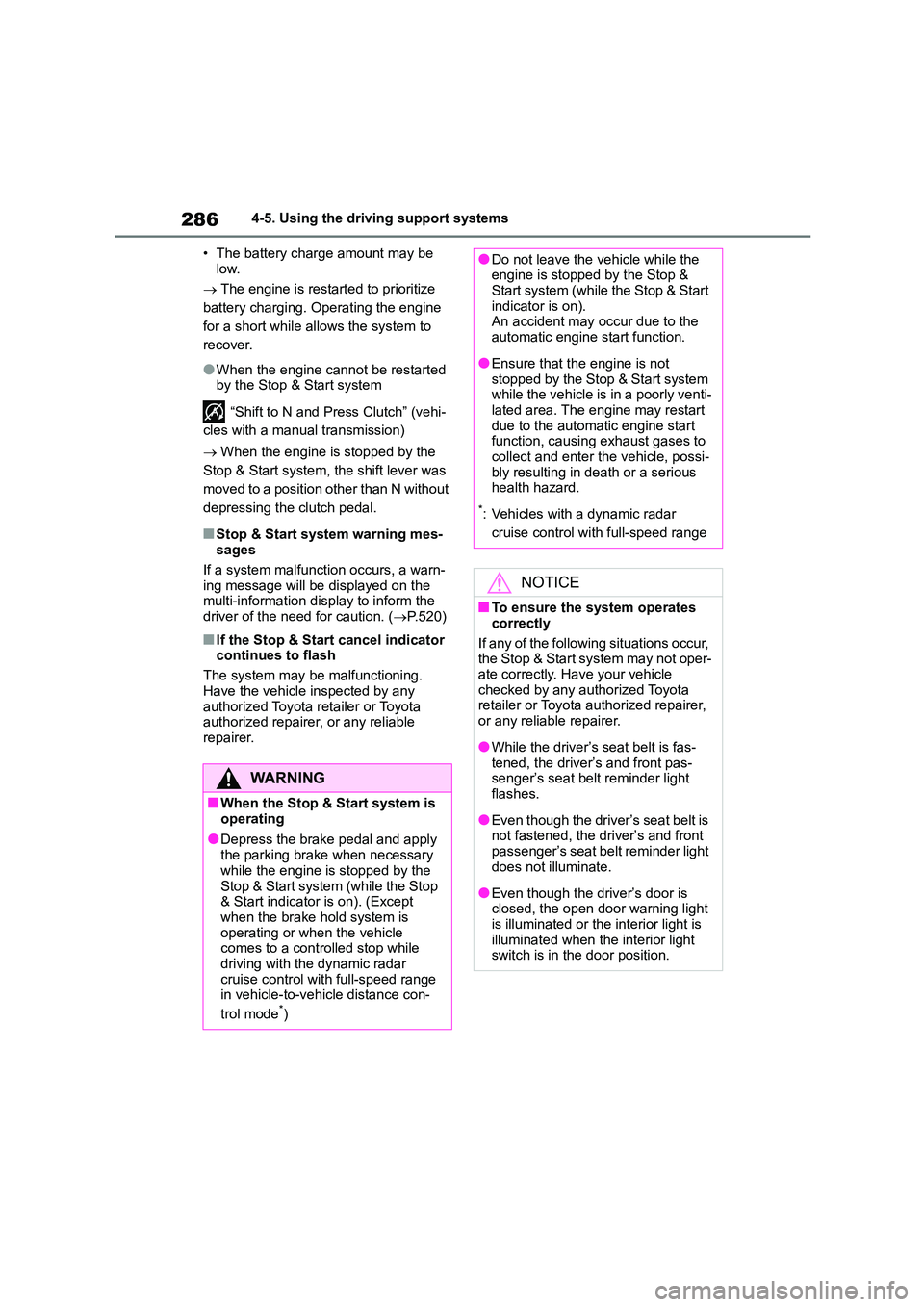
2864-5. Using the driving support systems
• The battery charge amount may be
low.
The engine is restarted to prioritize
battery charging. Operating the engine
for a short while allows the system to
recover.
●When the engine cannot be restarted
by the Stop & Start system
“Shift to N and Press Clutch” (vehi-
cles with a manual transmission)
When the engine is stopped by the
Stop & Start system, the shift lever was
moved to a position other than N without
depressing the clutch pedal.
■Stop & Start system warning mes- sages
If a system malfuncti on occurs, a warn-
ing message will be displayed on the multi-information display to inform the
driver of the need for caution. ( P.520)
■If the Stop & Start cancel indicator
continues to flash
The system may be malfunctioning.
Have the vehicle inspected by any
authorized Toyota retailer or Toyota authorized repairer, or any reliable
repairer.
WA R N I N G
■When the Stop & Start system is
operating
●Depress the brake pedal and apply
the parking brake when necessary
while the engine is stopped by the
Stop & Start system (while the Stop & Start indicator is on). (Except
when the brake hold system is
operating or when the vehicle comes to a controlled stop while
driving with the dynamic radar
cruise control with full-speed range in vehicle-to-vehicle distance con-
trol mode*)
●Do not leave the vehicle while the engine is stopped by the Stop &
Start system (while the Stop & Start
indicator is on). An accident may occur due to the
automatic engine start function.
●Ensure that the engine is not
stopped by the Stop & Start system
while the vehicle is in a poorly venti- lated area. The engine may restart
due to the automatic engine start
function, causing exhaust gases to collect and enter the vehicle, possi-
bly resulting in death or a serious
health hazard.
*: Vehicles with a dynamic radar
cruise control with full-speed range
NOTICE
■To ensure the system operates
correctly
If any of the following situations occur,
the Stop & Start syst em may not oper-
ate correctly. Have your vehicle checked by any authorized Toyota
retailer or Toyota authorized repairer,
or any reliable repairer.
●While the driver’s seat belt is fas-
tened, the driver’s and front pas- senger’s seat belt reminder light
flashes.
●Even though the driver’s seat belt is
not fastened, the driver’s and front
passenger’s seat belt reminder light does not illuminate.
●Even though the driver’s door is closed, the open door warning light
is illuminated or the interior light is
illuminated when the interior light switch is in the door position.
Page 289 of 758
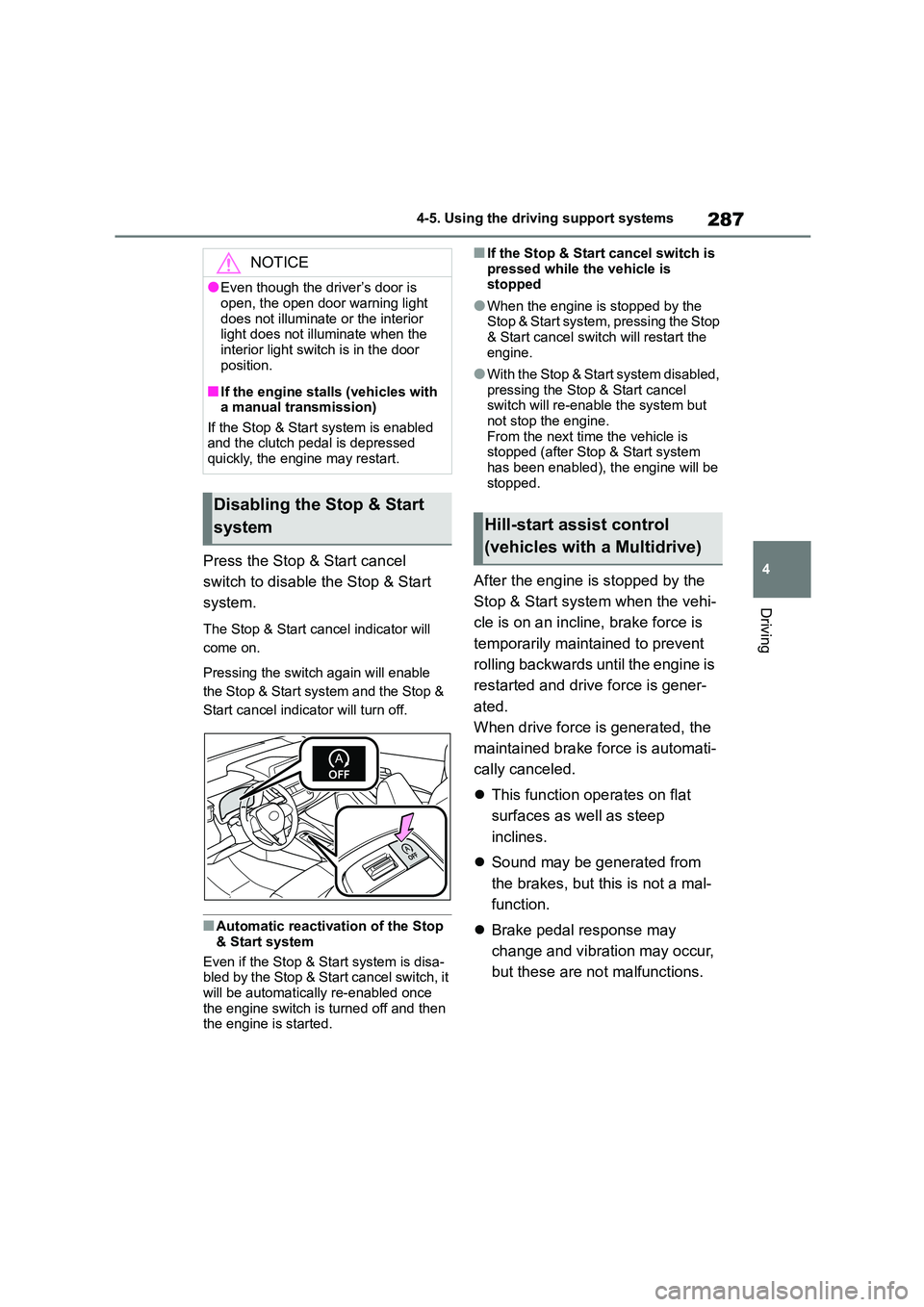
287
4
4-5. Using the driving support systems
Driving
Press the Stop & Start cancel
switch to disable the Stop & Start
system.
The Stop & Start cancel indicator will
come on.
Pressing the switch again will enable
the Stop & Start syst em and the Stop &
Start cancel indicator will turn off.
■Automatic reactivation of the Stop
& Start system
Even if the Stop & Start system is disa- bled by the Stop & Start cancel switch, it
will be automatically re-enabled once
the engine switch is turned off and then the engine is started.
■If the Stop & Start cancel switch is
pressed while the vehicle is stopped
●When the engine is stopped by the Stop & Start system, pressing the Stop
& Start cancel switch will restart the
engine.
●With the Stop & Start system disabled,
pressing the Stop & Start cancel switch will re-enable the system but
not stop the engine.
From the next time the vehicle is stopped (after Stop & Start system
has been enabled), the engine will be
stopped.
After the engine is stopped by the
Stop & Start system when the vehi-
cle is on an incline, brake force is
temporarily maintained to prevent
rolling backwards unt il the engine is
restarted and drive force is gener-
ated.
When drive force is generated, the
maintained brake force is automati-
cally canceled.
This function operates on flat
surfaces as well as steep
inclines.
Sound may be generated from
the brakes, but this is not a mal-
function.
Brake pedal response may
change and vibration may occur,
but these are not malfunctions.
NOTICE
●Even though the driver’s door is
open, the open door warning light
does not illuminate or the interior light does not illuminate when the
interior light switch is in the door
position.
■If the engine stalls (vehicles with
a manual transmission)
If the Stop & Star t system is enabled and the clutch pedal is depressed
quickly, the engine may restart.
Disabling the Stop & Start
systemHill-start assist control
(vehicles with a Multidrive)
Page 304 of 758
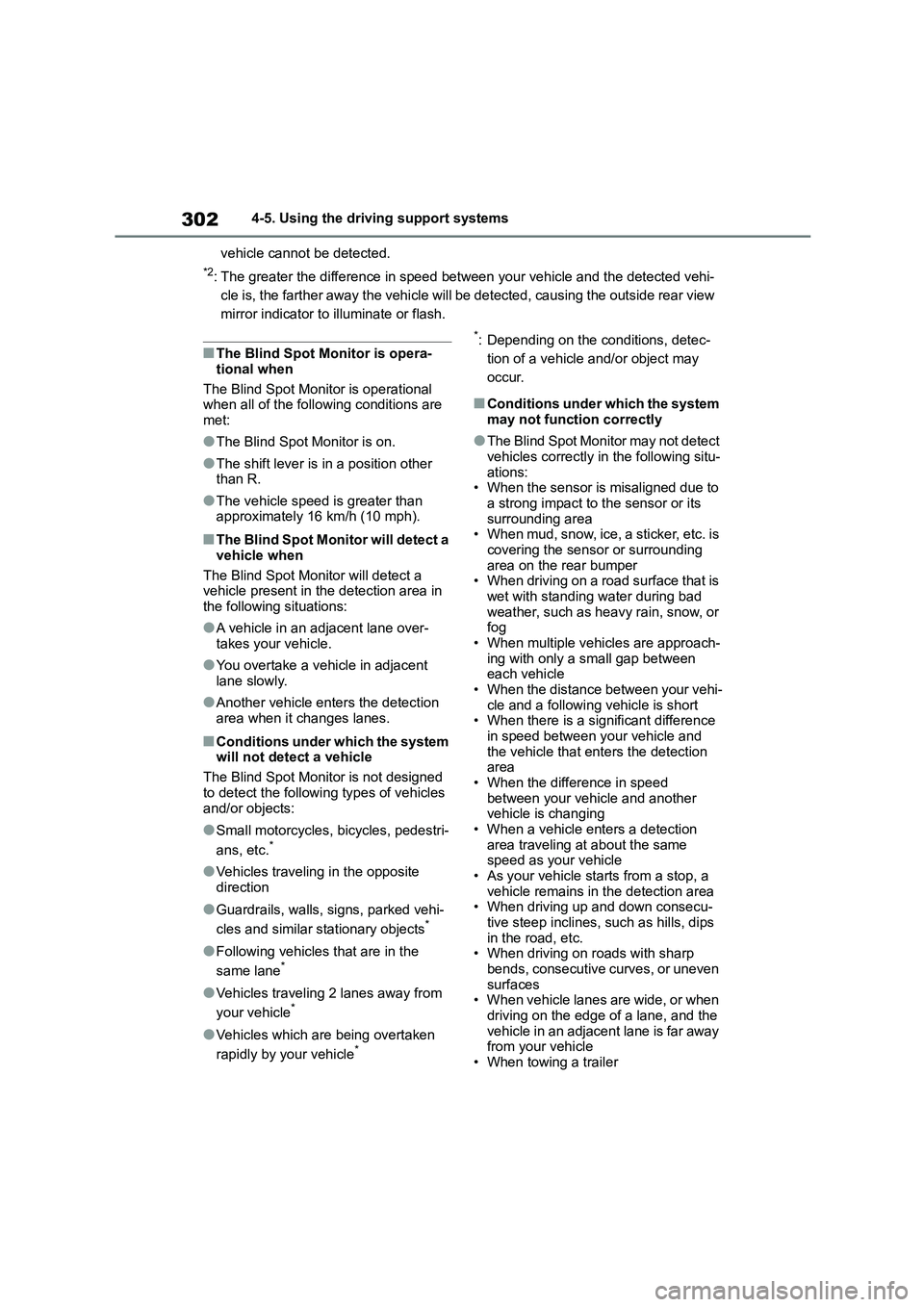
3024-5. Using the driving support systems
vehicle cannot be detected.
*2: The greater the difference in speed between your vehicle and the detected vehi-
cle is, the farther away the vehicle will be detected, causing the outside rear view
mirror indicator to illuminate or flash.
■The Blind Spot Monitor is opera-
tional when
The Blind Spot Monitor is operational
when all of the following conditions are
met:
●The Blind Spot Monitor is on.
●The shift lever is in a position other
than R.
●The vehicle speed is greater than
approximately 16 km/h (10 mph).
■The Blind Spot Monitor will detect a
vehicle when
The Blind Spot Monitor will detect a
vehicle present in the detection area in
the following situations:
●A vehicle in an adjacent lane over-
takes your vehicle.
●You overtake a vehicle in adjacent
lane slowly.
●Another vehicle enters the detection
area when it changes lanes.
■Conditions under which the system will not detect a vehicle
The Blind Spot Monitor is not designed
to detect the following types of vehicles
and/or objects:
●Small motorcycles, bicycles, pedestri-
ans, etc.*
●Vehicles traveling in the opposite
direction
●Guardrails, walls, signs, parked vehi-
cles and similar stationary objects*
●Following vehicles that are in the
same lane*
●Vehicles traveling 2 lanes away from
your vehicle*
●Vehicles which are being overtaken
rapidly by your vehicle*
*: Depending on the conditions, detec-
tion of a vehicle and/or object may
occur.
■Conditions under which the system may not function correctly
●The Blind Spot Monitor may not detect vehicles correctly in the following situ-
ations:
• When the sensor is misaligned due to a strong impact to the sensor or its
surrounding area
• When mud, snow, ice, a sticker, etc. is covering the sensor or surrounding
area on the rear bumper
• When driving on a road surface that is wet with standing water during bad
weather, such as heavy rain, snow, or
fog • When multiple vehicles are approach-
ing with only a small gap between
each vehicle • When the distance between your vehi-
cle and a following vehicle is short
• When there is a significant difference in speed between your vehicle and
the vehicle that enters the detection
area • When the difference in speed
between your vehicle and another
vehicle is changing • When a vehicle enters a detection
area traveling at about the same
speed as your vehicle • As your vehicle starts from a stop, a
vehicle remains in the detection area
• When driving up and down consecu-
tive steep inclines, such as hills, dips in the road, etc.
• When driving on roads with sharp
bends, consecutive curves, or uneven surfaces
• When vehicle lanes are wide, or when
driving on the edge of a lane, and the vehicle in an adjacent lane is far away
from your vehicle
• When towing a trailer
Page 328 of 758
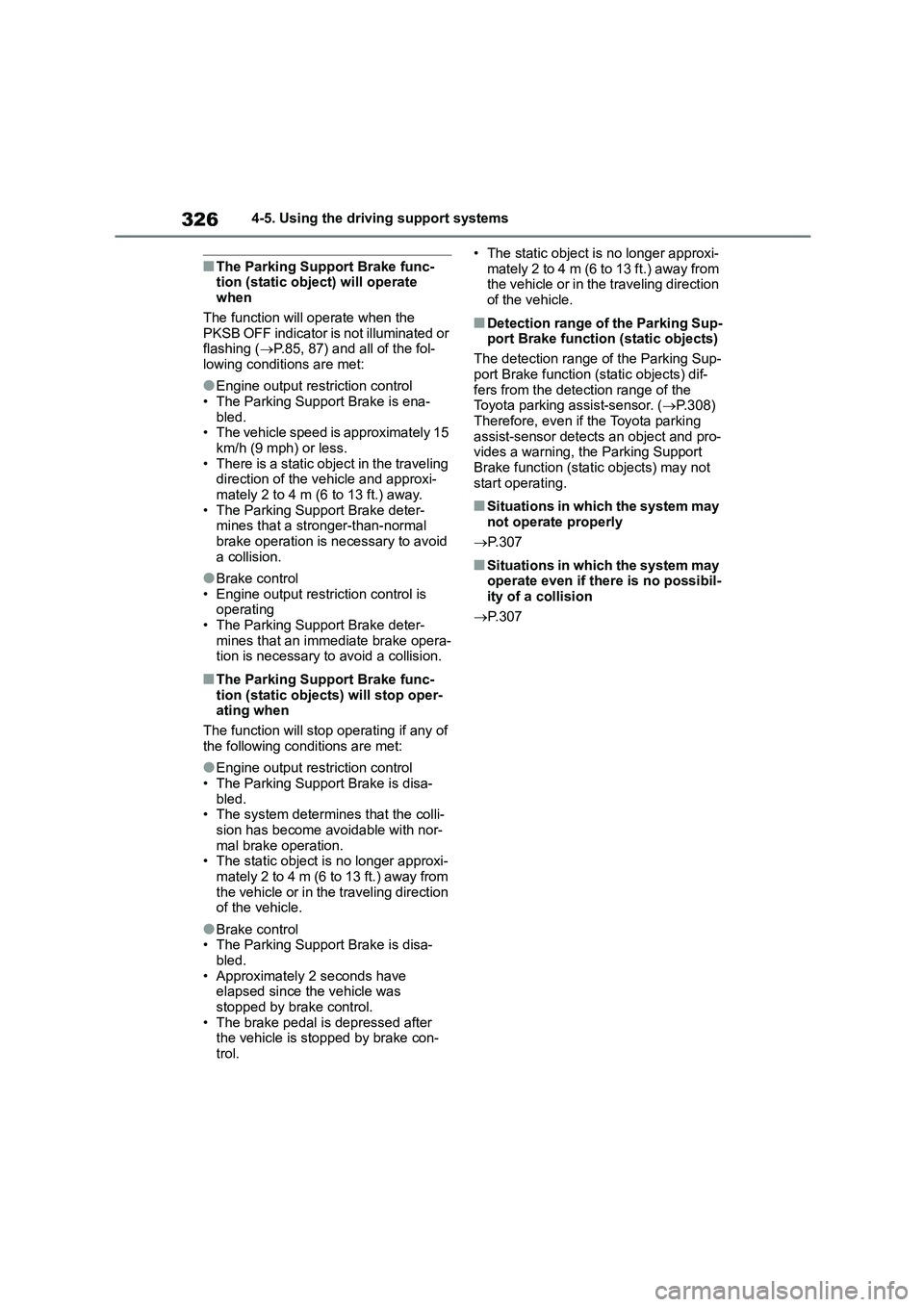
3264-5. Using the driving support systems
■The Parking Support Brake func- tion (static object) will operate
when
The function will operate when the PKSB OFF indicator is not illuminated or
flashing ( P.85, 87) and all of the fol-
lowing conditions are met:
●Engine output restriction control
• The Parking Support Brake is ena- bled.
• The vehicle speed is approximately 15
km/h (9 mph) or less. • There is a static object in the traveling
direction of the vehicle and approxi-
mately 2 to 4 m (6 to 13 ft.) away. • The Parking Support Brake deter-
mines that a stronger-than-normal
brake operation is necessary to avoid a collision.
●Brake control• Engine output restriction control is
operating
• The Parking Support Brake deter- mines that an immediate brake opera-
tion is necessary to avoid a collision.
■The Parking Support Brake func-
tion (static objects) will stop oper- ating when
The function will stop operating if any of
the following conditions are met:
●Engine output restriction control
• The Parking Support Brake is disa-
bled. • The system determines that the colli-
sion has become avoidable with nor-
mal brake operation. • The static object is no longer approxi-
mately 2 to 4 m (6 to 13 ft.) away from
the vehicle or in the traveling direction of the vehicle.
●Brake control• The Parking Support Brake is disa-
bled.
• Approximately 2 seconds have elapsed since the vehicle was
stopped by brake control.
• The brake pedal is depressed after the vehicle is stopped by brake con-
trol.
• The static object is no longer approxi-
mately 2 to 4 m (6 to 13 ft.) away from the vehicle or in the traveling direction
of the vehicle.
■Detection range of the Parking Sup-
port Brake function (static objects)
The detection range of the Parking Sup-
port Brake function (static objects) dif-
fers from the detection range of the Toyota parking assist-sensor. ( P.308)
Therefore, even if the Toyota parking
assist-sensor detects an object and pro- vides a warning, the Parking Support
Brake function (static objects) may not
start operating.
■Situations in which the system may not operate properly
P. 3 0 7
■Situations in which the system may
operate even if there is no possibil- ity of a collision
P. 3 0 7